NVIDIA's GeForce GTX 465: Cheaper Isn’t Always Better
by Ryan Smith on May 31, 2010 3:26 AM ESTPower, Temperature, & Noise
In our GTX 480 review, we identified both the GTX 480 and GTX 470 as being abnormally hot & loud. Perhaps with the reduction in functional units and a lower memory clock speed NVIDIA will be able to bring this in to check? Let’s find out.
Or not.
Let’s first start with core voltage. For the GTX 400 series NVIDIA does not use a single voltage for each card, instead they assign voltage on a per-chip basis. So while there are trends we can look at, there is no absolute single voltage as we’ve seen on past cards. The following is the load voltage on each of our sample cards.
| GeForce GTX 400 Series Load Voltage | |||
| GTX 480 | GTX 470 | GTX 465 | |
| Load Voltage |
0.959v
|
0.962v | 1.025v |
In terms of core voltage the GTX 465 ends up being a notable outlier. Our GTX 480 and 470 samples have a load core voltage of 0.959v and 0.962v respectively according to GPU-Z, while our GTX 465 from Zotec is a good 0.04v higher at 1.025v. This is only a 4% increase in core voltage overall, but as GF100 has an idle voltage of .875v, this means it takes a 50% greater voltage increase over idle to bring our GTX 465 to load compared to our GTX 470.
NVIDIA is dealing with some very tight thermal and power requirements on the GTX 480 and 470 – getting a 3 billion transistor chip to not run amok drawing power is hard work. From this we can infer that NVIDIA is not only holding back chips with damaged functional units, but also chips that run but just take too much voltage (and ultimately power) to do so. With fewer functional units, the GTX 465 has a greater tolerance for high-voltage chips and it looks like this is where NVIDIA is sending some of them as a result. This is why there’s only a 15W TDP difference between the two cards: NVIDIA “spent” their savings getting lesser GF100 GPUs in to products. So going by voltage alone, it’s clear that we’re not going to see the GTX 465 receive a huge benefit in terms of power, temperature, & noise.
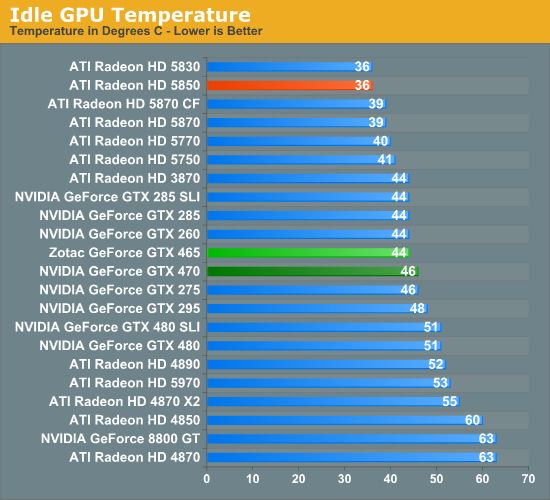
Moving on to our charts, we’ll start with idle temperatures. Even with the same idle voltage and same cooler as the GTX 470, the GTX 465 delivers a slight surprise: it ends up idling at 2C under the GTX 470. This puts it squarely in the same territory as the GTX 200 series.
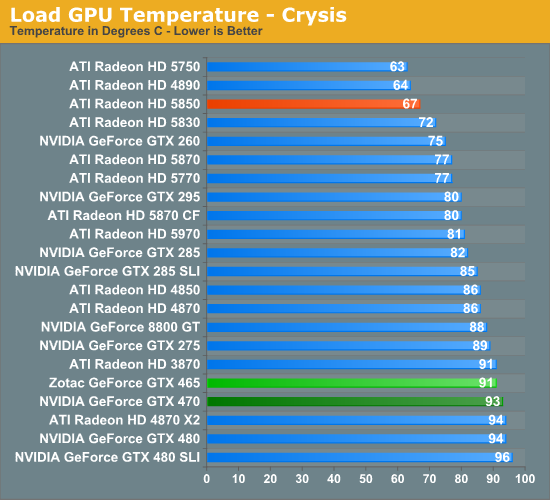
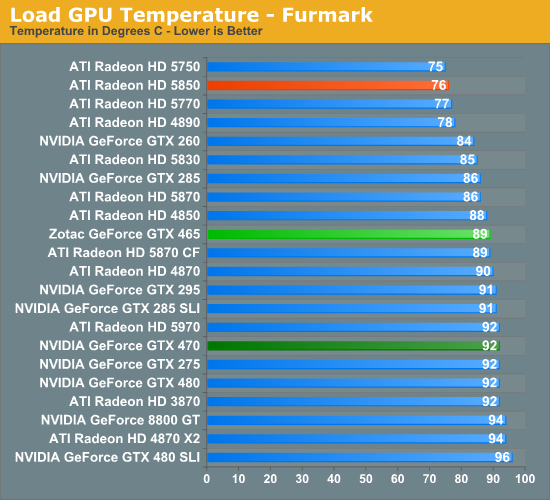
Moving on to load temperatures, we can begin to see the price of using a GPU with a higher core voltage. Under Crysis that 2C advantage over the GTX 470 holds, with temperatures peaking at just 91C. This still makes it the 3rd hottest single-GPU card we have tested, tieing with the Radeon HD 3870 and coming in 24C hotter than the 5850, a card it underperforms in this game.
FurMark has a similar showing, with the GTX 465 coming in 3C cooler than the GTX 470. Overall things are better for the GTX 465 here though, as it’s better than roughly half of our cards here, placing amongst the Radeon HD 4890, 4850, and only a hair above the 5870 and GTX 285. Even the gap between the GTX 465 and 5850 drops quite a bit, with only 13C separating the two.

Next we have idle power consumption, measuring the total power consumption of our GPU testbench. While NVIDIA didn’t give the GTX 465 an official idle power draw, we’re measuring it at 1W less than the GTX 470. The GTX 470 was rated for 33W, so it’s safe to say the GTX 465 is close to that. It’s quite likely that the difference comes down to the savings from running 2 fewer GDDR5 RAM chips.
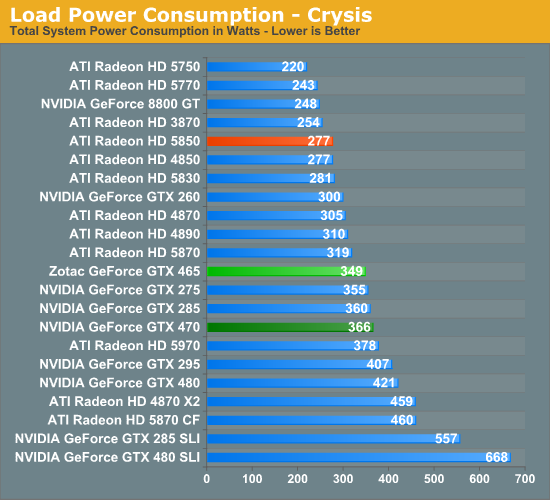
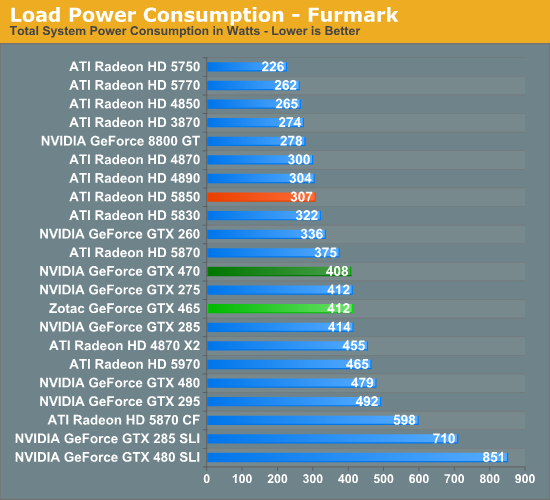
As for load power draw, having seen our temperature results the actual power figures should not be a surprise. Under Crysis the GTX 465 has more in common with the GTX 470 than the power-saving Radeon HD 5000 series, drawing 17W less than the GTX 470 and 72W more than the 5850. Based on our voltage numbers from earlier and this data, it’s clear that NVIDIA had to give up a lot of power savings to make this specific GPU operate.
Meanwhile under FurMark we see those savings evaporate in to nothingness. Here the GTX 465 actually surpasses the GTX 470 by 4W, coming in at 412W versus 408W. At this point it’s drawing as much power as a GTX 275/285, and 105W more than the Radeon 5850. We did not expect the GTX 465 to end up drawing more power than the GTX 470 here, as the 2 fewer RAM chips should have offset the difference. Looking at just the GPU, there’s a good chance the GPU in our GTX 465 card is drawing more power than the GTX 470 under most situations.
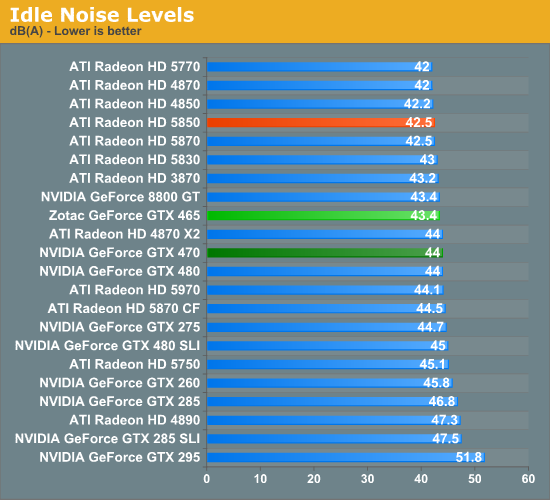
Last but not least we have our noise testing. As the GTX 465 uses the same cooler as the GTX 470, the results should be very close and our idle noise measurements deliver on that. Our GTX 465 idles at 43.4db(A), effectively tied with the GTX 470 and only marginally different than most of the rest of our cards.
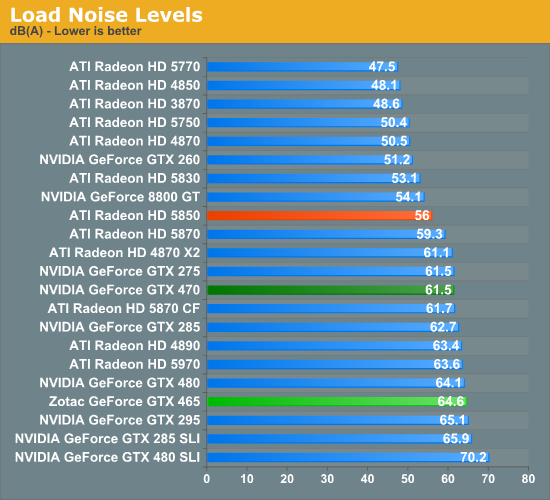
When we first did our load noise testing on our GTX 465, we thought something was wrong. It sounded louder than the GTX 480 or GTX 470, and when we put a sound meter to it the results reflected that. But after triple-checking our results there’s nothing wrong with our data – the GTX 465 really is louder than the GTX 470 and the GTX 480. As fan speeds are tied to the GPU temperature we’re looking at the culprit being the fan profile used for the GTX 465, as the hardware is identical to the GTX 470. It looks like NVIDIA tweaked the GTX 465 to be a bit more aggressive than the GTX 470, which in turn makes this the likely reason why we’ve measured the GTX 465 as being cooler than the GTX 470 in spite of their similar power draw.
Our best guess here is that with the GTX 465’s higher operating voltage, NVIDIA wanted a slightly lower operating temperature to compensate. As with any other case where we’ve only measured a single card there’s the possibility of a great deal of variation, but what we’ve seen makes sense. Across the entire spectrum of GTX 465 and GTX 470 cards it’s reasonable to assume this data is correct and that the GTX 465 is on average a couple of db(A) louder than the GTX 470.
It goes without saying that this isn’t a reasonable amount of noise for the performance the card delivers. The Radeon HD 5870 is 5dB(A) quieter, and the 5850 extends than to 8dB(A) quieter. At these noise levels 8dB(A) is a very noticeable difference.










71 Comments
View All Comments
BoFox - Tuesday, June 1, 2010 - link
10.5's offer almost zero performance improvements over 10.3a. Remember, the 10.3 drivers already brought the largest boost to 5xxx cards since they came out in October.Lapoki - Tuesday, June 1, 2010 - link
With the latest series from ATI and nVidia one thing that didnt happen at all were the price wars. I loved watching that with the last gen and remember the day when i almost purchased a non-reference 4890 for just $179.Then came the 58XX and i thought i'd wait for nVidia's response which took quite a while but in the end i was sorely dissapointed. It looked like both teams had decided upon a performance point to target with a price
$250 - HD 5830
$280 - GTX465
$300 - HD 5850
$350 - GTX470
$400 - HD5870
$500 - GTX480
Is it just me or these alternating figures look fishy?
In the end, after delaying my purchase by quite a few months, i gave up and bought a 5850 for ~$280 and i have to say i really like its performance though wish i it was cheaper by $30-$40.
Also, this is my first ATI or for that matter non-nVidia card in 12 years.
BoFox - Tuesday, June 1, 2010 - link
Yeah! Nvidia is deliberately avoiding price wars by avoiding the exact same price categories this time around.ATI's Southern Islands (HD 6770) is due in a couple months or less, since it already taped out. It will give GTX 480 a spanking, for sure.
ragejg - Tuesday, June 1, 2010 - link
In my GTX 465 review for nVNews I took an average for a 1 minute run in a repeatable firefight in SP, and a 1 minute run in a full MP server. How did you guys do the BC2 benching? Could you explain what the waterfall benchmark entails, as well as the other one? I'd like to do a better job of benchmarking with this game.- john
-nVNews Staff/Mod
Ryan Smith - Tuesday, June 1, 2010 - link
The text and pictures from our GTX 480 review should do a good enough job explaining our test methodology.http://www.anandtech.com/show/2977/nvidia-s-geforc...
Chalnoth - Tuesday, June 1, 2010 - link
"Above the GTX 480 is of course the “full” GF100 with all of its functional units enabled, and which is still missing in action on both the consumer and HPC markets."What the hell are you smoking? As of the time of this post, all 10 GTX 480 products listed on newegg's website were ready for immediate shipping. Can you at least get your simplest facts straight?
silverblue - Tuesday, June 1, 2010 - link
He said the "full" GT100, which offers 512 shader cores and not 480 as is the case with the 480. As such, I believe he's correct to make that statement.silverblue - Tuesday, June 1, 2010 - link
They used Catalyst v10.5, and the 5830 was far closer to the 465. In most games, it was behind at the lower resolutions, then ahead as you went higher. Pretty easy to conclude that, unless you're playing MW2, the 465 was a waste of time unless you wanted PhysX, CUDA and 3D gaming/BluRay.I know you use a different gaming test suite but I'm surprised that the 5830 is relatively nowhere on your test. Are you using AA at any point?
BoFox - Tuesday, June 1, 2010 - link
Perhaps you are the owner of a 5830, but just check dozens of review sites out there and see for yourself how a 5830 is rather lackluster even compared to the 4890 (which is already slower than GTX 275 and 465 in overall DX9/10 games).Slayeristight - Tuesday, June 1, 2010 - link
I just lost a lot of respect for this website with the posting of these benchmarks. I looked at the 5830 number and they are very, very low. I compared the numbers from this review to the of the 5830 and they are a lot lower! How can this be with all the performance upgrades in the drivers that they have had. Also, while I am speaking of drivers, why not use the newest drivers for ATI? Why use AMD Catalyst 10.3a that is 2 driver releases old?If you messed up on the 5830 so bad how can I trust any of the other numbers that were put up for any of the other cards be it Nvidia or ATI?